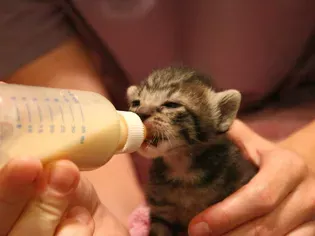How to Bottle Feed Your Newborn Kittens
Updated on 04/26/24

Bottle Feeding Your Newborn Kittens: A Comprehensive Guide
Introduction
Bringing home newborn kittens is an incredibly rewarding experience, but it also comes with significant responsibilities. One of the most important tasks is ensuring they receive adequate nutrition, especially if their mother is unable to provide it. Bottle feeding your kittens is a delicate and essential process that requires patience, attention to detail, and a deep understanding of their needs. This comprehensive guide will provide you with everything you need to know to bottle feed your newborn kittens successfully, ensuring their health, growth, and well-being.
Understanding Kitten Nutrition
Newborn kittens have unique nutritional requirements that differ significantly from those of adult cats. Their bodies are rapidly growing and developing, so they need a diet rich in calories, protein, and fat. Kitten milk replacer (KMR) is specially formulated to meet these nutritional needs. It provides essential nutrients, including:
* Proteins: For muscle repair and growth
* Fats: For energy and brain development
* Carbohydrates: For quick energy and warmth
* Vitamins and minerals: For overall health and development
Preparing the Bottle
* Choose the right bottle: Use a small, soft nipple bottle designed specifically for kittens. Avoid using bottles with large holes, as kittens may ingest too much milk too quickly.
* Warm the milk: Heat the KMR to body temperature (100-102°F) using a bottle warmer or by placing it in a warm water bath. Never microwave the milk, as this can create hot spots that can burn the kitten's mouth or esophagus.
* Measure carefully: Ensure you follow the instructions on the KMR package to measure the correct amount of powder to water ratio. Too much powder can make the milk too thick, while too little can result in insufficient nutrition.
Feeding the Kitten
* Hold the kitten securely: Cradle the kitten in the palm of your hand, supporting its head and neck with your thumb.
* Position the bottle correctly: Gently guide the bottle nipple into the kitten's mouth. Tilt the bottle slightly to allow milk to flow.
* Observe the kitten's breathing: Keep an eye on the kitten's breathing while feeding. If they begin to struggle or choke, stop feeding immediately and consult a veterinarian.
* Feed slowly: Let the kitten drink at its own pace. Avoid forcing milk down its throat, as this can lead to aspiration.
* Burp the kitten: After feeding, gently rub the kitten's back or hold it upright to help them burp any excess air.
Feeding Schedule and Quantity
* Feeding frequency: Newborn kittens require frequent feedings, typically every 2-3 hours around the clock. As they grow, the feeding frequency can be gradually reduced.
* Feeding amount: The amount of milk each kitten needs will vary depending on their age and weight. Start with small amounts (1-2 milliliters per feeding) and increase as the kitten grows. Consult with a veterinarian for specific feeding guidelines.
Additional Tips
* Keep the kittens warm: Newborn kittens cannot regulate their own body temperature, so it's crucial to keep them warm. Use a heating pad or a warm water bottle wrapped in a towel.
* Stimulate elimination: Gently rub the kitten's genital area with a warm, damp cotton ball to stimulate elimination. Kittens may not be able to eliminate on their own in the first few days.
* Monitor the kittens' weight: Weigh the kittens regularly to ensure they are gaining weight at an appropriate rate. If they are not gaining weight or losing weight, consult a veterinarian immediately.
* Keep the feeding area clean: Wash the bottle, nipple, and any other utensils thoroughly after each feeding to prevent bacterial growth.
* Seek professional advice: If you encounter any difficulties or concerns while bottle feeding your kittens, do not hesitate to consult with a veterinarian. They can provide expert advice and guidance to ensure the kittens' health and well-being.
Conclusion
Bottle feeding newborn kittens can be a challenging but rewarding experience. By following the steps outlined in this comprehensive guide, you can provide your kittens with the essential nutrients they need to thrive. Remember to be patient, attentive, and seek professional advice when necessary. With proper care and nutrition, your newborn kittens will grow into healthy, happy companions for years to come.
Explore More Pets

Cat Behavior Problems
How to Stop Aggression in Kittens

Long-Haired Cat Breeds
Siberian Cat: Breed Profile, Characteristics, & Care

Cat Behavior Problems
How to Stop Kittens From Scratching and Biting

Long-Haired Cat Breeds
Turkish Angora: Cat Breed Profile, Characteristics & Care

Basic Training
How to Socialize Your Kitten

Short-Haired Cat Breeds
Cute Pictures & Facts About Calico Cats & Kittens

Litter Box Training
Training Your Kitten to Use the Litter Box

Long-Haired Cat Breeds
10 Fun Facts About White Cats